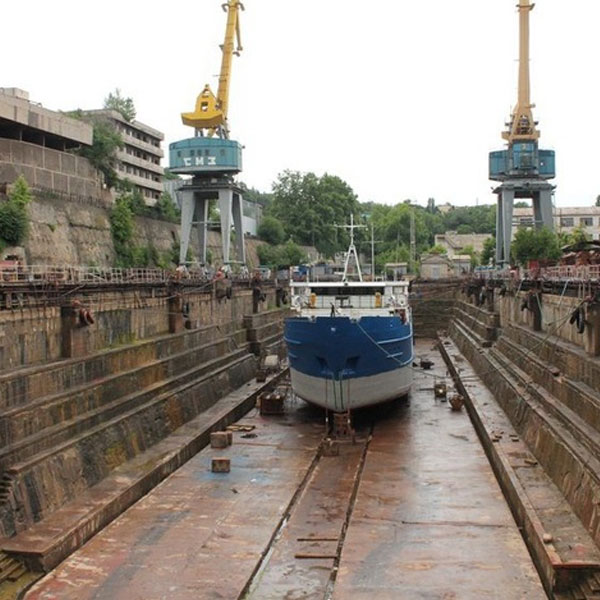
Reliable supplier of rubber products for ships and berths
February 13, 2025
Sevmorzavod is regaining momentum after nationalization. The United Shipbuilding Corporation (USC) is creating a shipbuilding cluster in Crimea, which will include a branch of the Zvezdochka Ship Repair Center at Sevmorzavod, the Coral Central Design Bureau, Feodosia’s Sudokompozit plant, and Sevastopol State University. Crimean shipbuilders have already secured their first shipbuilding orders and are preparing to collaborate with other USC enterprises.
Sevmorzavod regains momentum after nationalization. Photo: Yulia Krymova/RG
Sevmorzavod, whose facilities have been leased by Severodvinsk-based Zvezdochka since 2015, last week received its first shipbuilding order in years. The enterprise will build a massive pontoon complex for the Kerch Bridge construction. Design work will be handled by Sevastopol’s Coral Central Design Bureau. The complex will enable the transport of prefabricated 4,500-ton steel arch spans for the bridge’s road section and 5,000-ton spans for the railway section via tugboats to assembly sites in the Kerch Strait.
Under the contract, Sevmorzavod will produce four steel pontoons (60.2 x 16.5 meters, 5-meter hull depth) by the end of 2016. Each pontoon weighs 665 tons. In the second stage, pontoons will be paired as catamarans, equipped with ballast systems for controlled submersion during loading. In total, Sevmorzavod workers will fabricate over 2,600 tons of metal structures.
— This large-scale order will help the Sevastopol shipyard return to its core expertise: shipbuilding and crane vessel construction, — said Igor Drey, director of Zvezdochka’s Sevastopol branch.
Sevmorzavod is currently USC’s largest operational enterprise in Crimea, having completed nearly 20 military and civilian ship repair orders in 2015–2016. It will now expand into shipbuilding.
— The plant’s unique expertise in crane equipment production makes it valuable both as an internal contractor and as a supplier of floating cranes for external markets, — said Dmitry Kolodyazhny, USC Vice President for Technical Development.
Half of all crane orders are expected to come from non-USC entities, such as port operators and shipbuilders. The other half will be sourced internally.
— Nearly every USC plant has modernization plans requiring new crane systems, — Kolodyazhny added. — For example, the 1,200-ton “Goliath” crane at Severnaya Verf costs billions of rubles. A few such orders could keep Sevmorzavod busy for years.
USC plans to execute commercial orders in partnership with other crane manufacturers, including talks with the SoyuzKran association to localize production.
Soon, Sevmorzavod will receive modern metalworking and welding equipment under USC’s modernization program, alongside facility upgrades.
Precision Shipbuilding
The Coral Central Design Bureau, known for offshore drilling rigs and crane vessel designs, will collaborate with Sevmorzavod. It is now integrating into USC’s digital design network, adopting 3D modeling and secure data exchange.
Feodosia’s Sudokompozit, specializing in composite materials, will join the cluster as a branch of St. Petersburg’s Sredne-Nevsky Shipyard. It will develop composite solutions for military and civilian vessels.
— Sudokompozit combines R&D and production capabilities, — Kolodyazhny noted. — Composite superstructures are already used on Amur Shipyard and Severnaya Verf warships. Future projects include wind turbine blades in partnership with Rusnano.
To enable cooperation across USC, Crimean enterprises must adopt digital tools like laser scanners and trackers to eliminate manual adjustments during assembly.
— Current shipbuilding requires extensive fitting work, — Kolodyazhny explained. — Digitalization ensures components from different plants fit perfectly.
Unmanned Research Vessel
Sevastopol State University will train specialists for the cluster and launch a shipbuilding department in 2016. Jointly with USC and Russia’s Ministry of Education, it is developing the unmanned research vessel Pioneer-M.
— Pioneer-M will have three control modes: crewed, remote, and fully autonomous, — said project lead Maxim Evstigneev. — By 2018, it will perform unmanned missions. A robotic port in Holland Bay will enable autonomous docking and equipment swaps.
— Unmanned vessels could cut research costs fivefold by eliminating crews, — Evstigneev added. — This aligns with the National Technology Initiative, targeting 1% of the global shipbuilding market (≈$1.5 billion) by 2030.
SevSU aims to design research vessels (NIS) for Russia’s aging fleet, 75 of which require replacement.
In Other News
The State Unitary Enterprise Sevmorzavod, established during Crimea’s transition, will repay 2.8 million rubles in unpaid vacation allowances to 300 former employees of Ukraine’s Sevastopol Marine Plant. The debt will be settled using lease payments from Zvezdochka.
Text: Yulia Krymova (Sevastopol)
Shipbuilding
News
from the company TransTechnology
